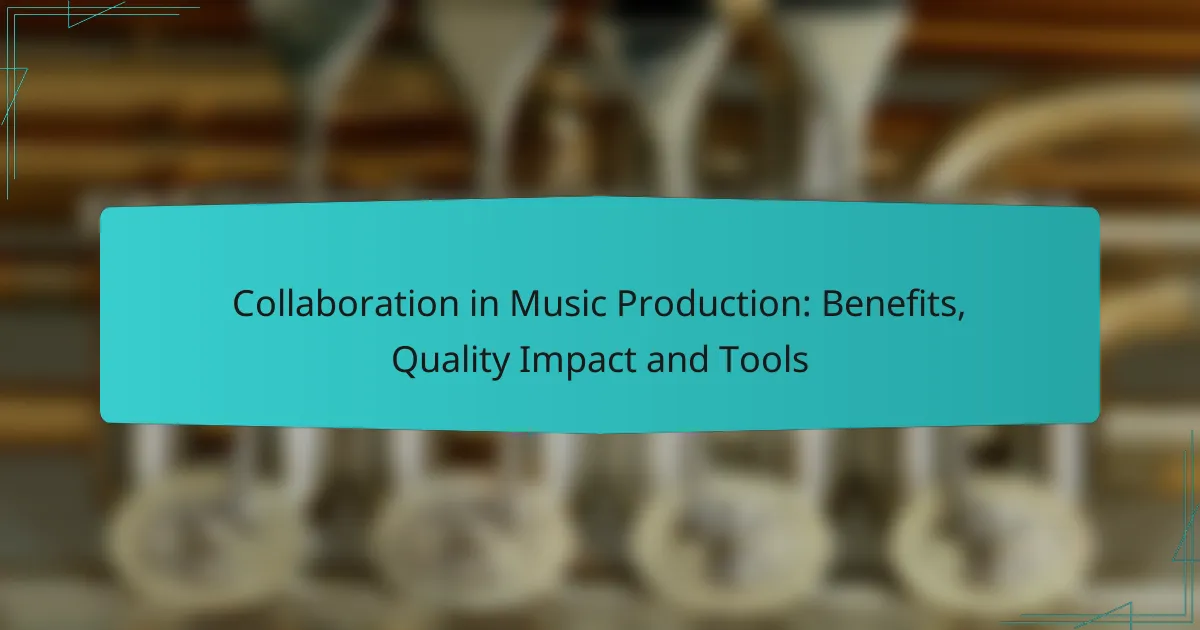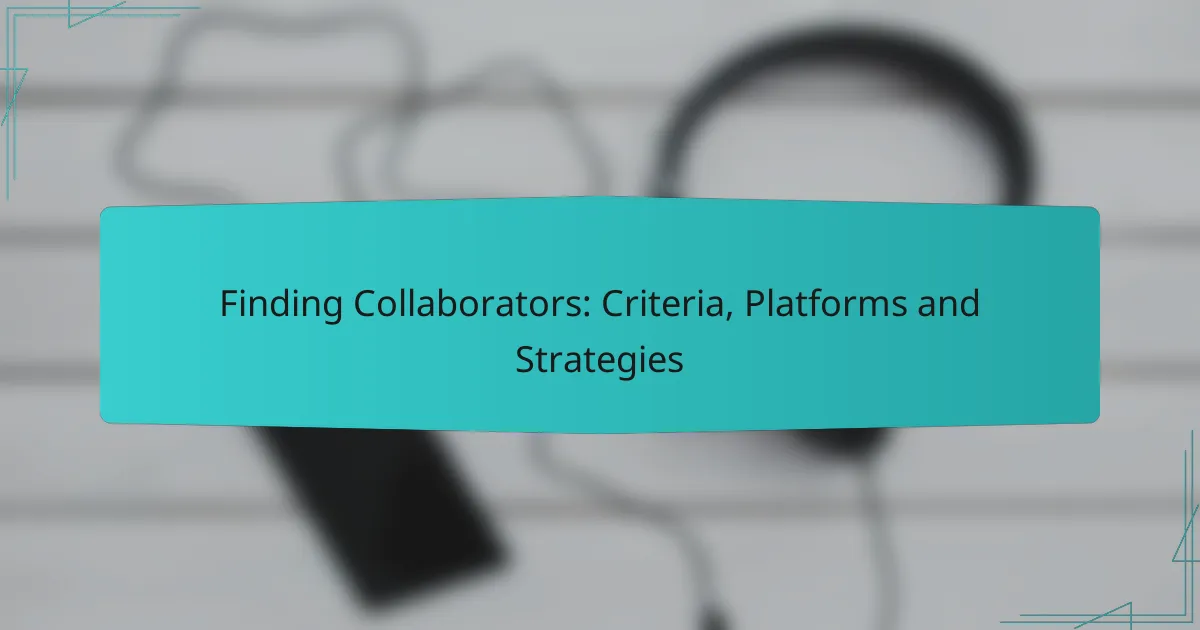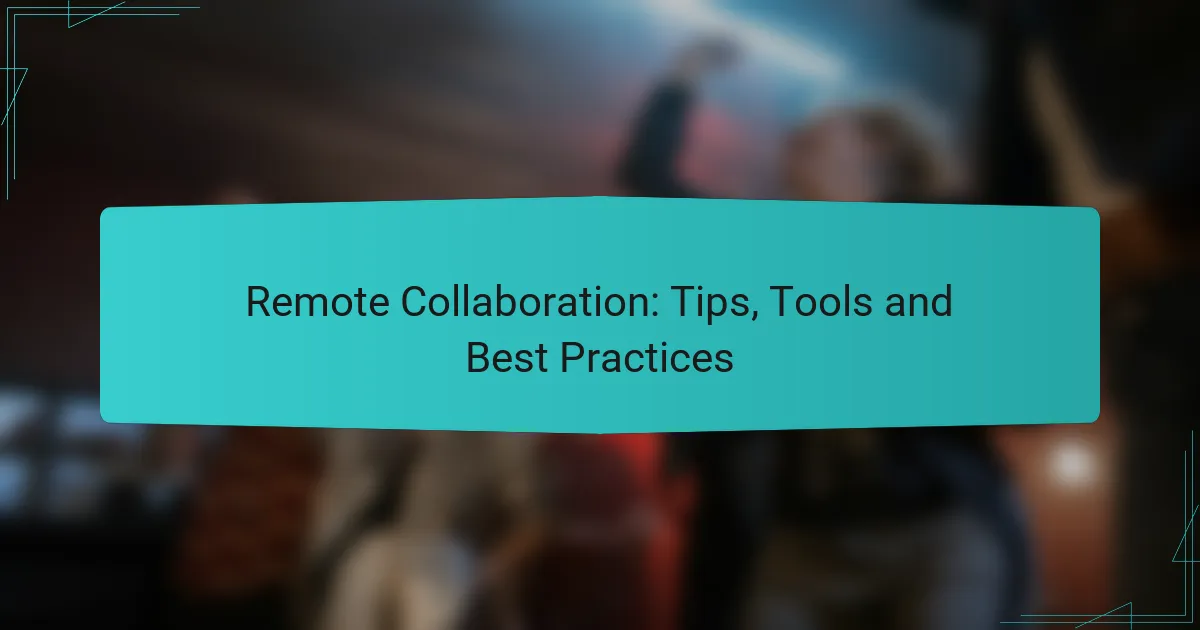Collaboration in music production is a powerful catalyst for creativity and quality, as it brings together diverse skills and perspectives that enrich the final product. By leveraging the strengths of various artists and producers, teams can create more innovative and polished music. Additionally, modern collaboration tools facilitate seamless teamwork, enabling real-time editing and cloud storage to enhance the creative process, regardless of geographical barriers.

How does collaboration enhance music production quality?
Collaboration significantly enhances music production quality by integrating diverse skills and perspectives, leading to more innovative and polished final products. When artists and producers work together, they can leverage each other’s strengths, resulting in a richer creative output.
Improved creativity through diverse perspectives
Collaborating with others introduces a variety of ideas and influences that can spark creativity. Different backgrounds and experiences allow collaborators to approach music from unique angles, often resulting in unexpected and innovative sounds.
For example, a hip-hop producer working with a classical musician can blend genres in ways that neither could achieve alone, creating a fresh and engaging track. This cross-pollination of styles can lead to the development of new musical trends.
Higher production value with expert input
Working with experienced collaborators can elevate the production quality of a track. Each contributor may bring specialized skills, such as mixing, mastering, or instrumentation, which can enhance the overall sound.
For instance, involving a professional sound engineer can ensure that the final mix meets industry standards, making it more competitive in the market. This expertise often translates into a more polished and radio-ready product.
Streamlined workflow and efficiency
Collaboration can lead to a more efficient workflow by distributing tasks among team members. When each person focuses on their strengths, the production process can move faster and with fewer bottlenecks.
Using collaborative tools like digital audio workstations (DAWs) that allow multiple users to work simultaneously can further streamline this process. This can reduce the time spent on revisions and improve the overall productivity of the music production team.
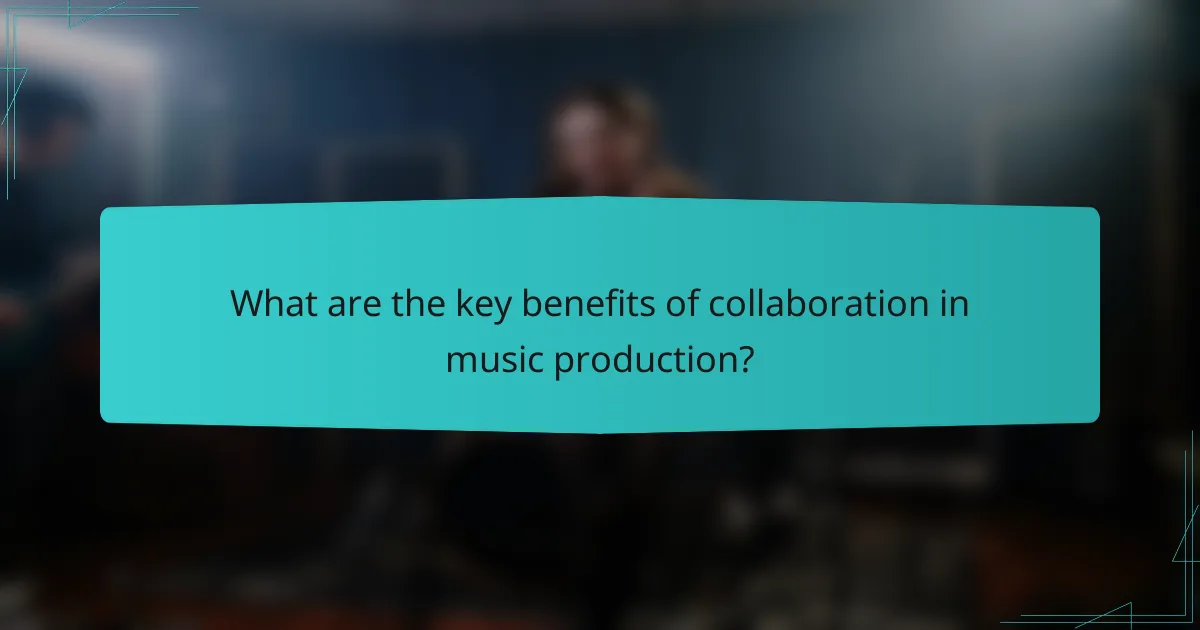
What are the key benefits of collaboration in music production?
Collaboration in music production offers several key benefits, including enhanced creativity, improved quality, and access to diverse expertise. By working with others, producers can leverage different skills and perspectives, ultimately leading to a more polished final product.
Access to a wider range of skills
Collaborating with other musicians and producers allows for a broader skill set to be utilized in the production process. For instance, one collaborator might excel in songwriting while another is proficient in mixing and mastering. This combination can elevate the overall quality of the music.
When forming a team, consider the specific skills each member brings. Look for individuals with complementary strengths, such as a strong background in electronic music production paired with expertise in live instrumentation. This synergy can lead to innovative soundscapes.
Increased networking opportunities
Collaboration naturally expands your professional network, connecting you with other artists, producers, and industry professionals. These relationships can lead to future projects, gigs, and valuable referrals, enhancing your career prospects in the music industry.
To maximize networking benefits, actively engage with your collaborators beyond the project at hand. Attend industry events together, share each other’s work on social media, and maintain open lines of communication. This can create lasting partnerships that benefit all parties involved.
Shared resources and tools
Working with others often means sharing access to valuable resources, such as high-quality recording equipment, software, and studio space. This can significantly reduce costs, especially for independent artists who may not have the budget for professional-grade tools.
When collaborating, discuss and agree upon the resources each party can contribute. Create a list of shared tools and establish guidelines for their use to avoid misunderstandings. This collaborative approach can enhance the production process and lead to more efficient workflows.
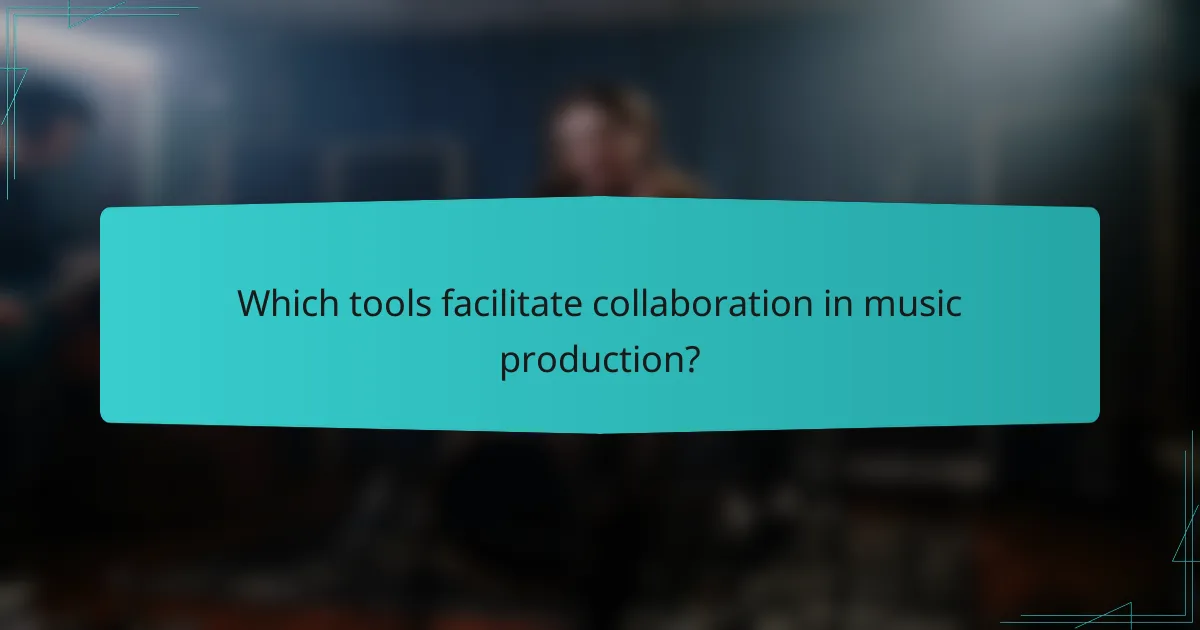
Which tools facilitate collaboration in music production?
Several tools enhance collaboration in music production by allowing multiple users to work together seamlessly, regardless of their location. These platforms offer features such as real-time editing, cloud storage, and user-friendly interfaces to streamline the creative process.
Ableton Live for real-time collaboration
Ableton Live is a powerful digital audio workstation (DAW) that supports real-time collaboration through its Link feature. This allows multiple users to sync their sessions over a local network or the internet, enabling musicians to jam together live.
To get started, ensure all collaborators have the same version of Ableton Live and are connected to the same network. Keep in mind that latency can vary based on internet speed and connection quality, so testing your setup before a session is advisable.
Splice for cloud-based project sharing
Splice is a cloud-based platform designed for sharing music projects and samples among collaborators. Users can upload their Ableton Live projects, and others can download, edit, and re-upload changes, making it easy to collaborate asynchronously.
When using Splice, consider organizing your project files clearly and using version control to avoid confusion. It’s also beneficial to communicate regularly with your collaborators to ensure everyone is on the same page regarding changes and updates.
Soundtrap for online music creation
Soundtrap is an online music studio that allows users to create music collaboratively in real-time. It operates directly in a web browser, making it accessible without the need for software installation.
To collaborate effectively on Soundtrap, invite team members via email to join your project. Utilize the built-in chat feature for communication during sessions. Be mindful of the platform’s limitations, such as fewer advanced features compared to traditional DAWs, but it excels in ease of use and accessibility for beginners.

What criteria should be considered when choosing collaboration tools?
When selecting collaboration tools for music production, consider compatibility with existing software, ease of use for all collaborators, and cost or subscription models. These factors significantly influence the effectiveness and efficiency of your collaborative efforts.
Compatibility with existing software
Ensure that the collaboration tools you choose integrate seamlessly with the software already in use by your team. Look for tools that support popular digital audio workstations (DAWs) like Ableton Live, Pro Tools, or Logic Pro, as this will minimize workflow disruptions.
Check for file format compatibility as well. Tools that allow for easy sharing of project files, stems, and audio samples will enhance collaboration and reduce the time spent on technical issues.
Ease of use for all collaborators
The chosen tools should be user-friendly for everyone involved, regardless of their technical expertise. A steep learning curve can hinder productivity, so opt for platforms with intuitive interfaces and clear documentation.
Consider conducting a trial run with all collaborators to gauge their comfort level with the tools. Feedback from this session can help identify any potential barriers to effective collaboration.
Cost and subscription models
Evaluate the cost of collaboration tools, including one-time purchases versus subscription models. Some tools may offer free versions with limited features, while others may require monthly or annual fees that can add up over time.
Compare the pricing structures to ensure they fit within your budget. Look for options that provide good value for the features offered, and consider whether the investment aligns with your team’s collaboration needs.
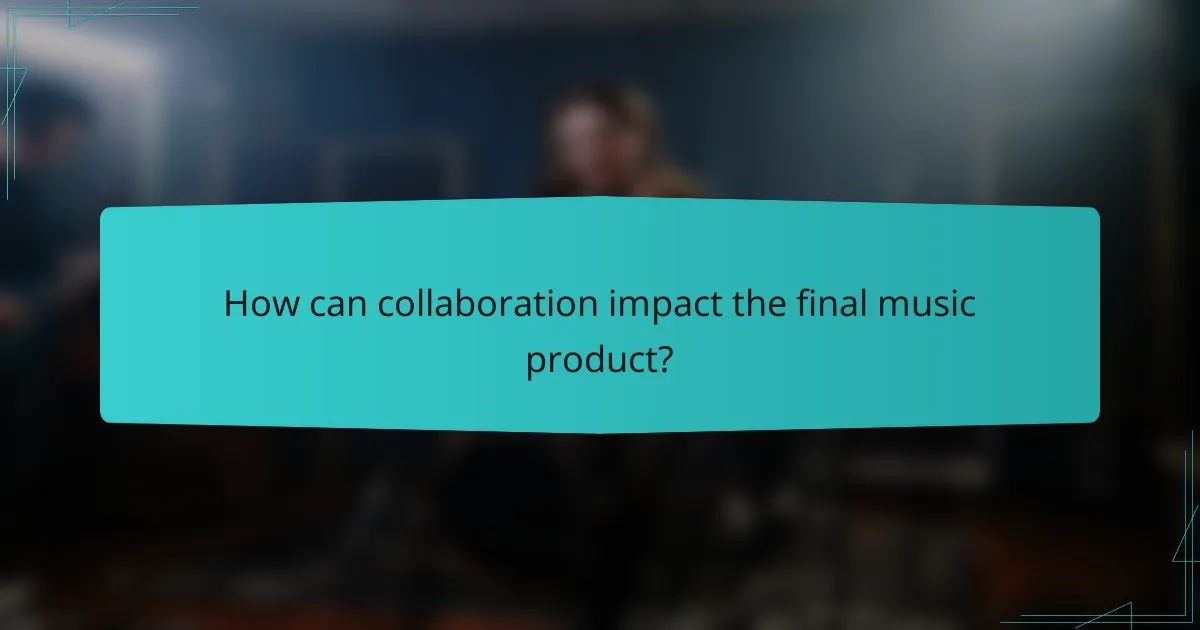
How can collaboration impact the final music product?
Collaboration can significantly enhance the quality and appeal of a music product by integrating diverse skills and perspectives. By working together, artists can refine their sound and reach wider audiences through varied influences.
Enhanced sound quality through expert feedback
Collaborating with other musicians or producers allows for valuable feedback that can elevate sound quality. Each participant brings unique expertise, whether in songwriting, instrumentation, or production techniques, which can lead to a more polished final product.
For instance, a vocalist might collaborate with a seasoned producer who can suggest adjustments to vocal arrangements or mixing techniques. This exchange often results in a richer, more dynamic sound that resonates better with listeners.
Broader audience appeal with diverse influences
Working with collaborators from different musical backgrounds introduces new influences that can broaden the appeal of a track. This diversity can attract listeners from various genres, increasing the potential audience size.
For example, a pop artist collaborating with a hip-hop producer can create a fusion track that appeals to fans of both genres. This strategy not only enhances creativity but also taps into different market segments, which can be particularly beneficial for independent artists looking to expand their reach.

What are the emerging trends in collaborative music production?
Emerging trends in collaborative music production focus on leveraging technology to enhance creativity and streamline workflows. Key developments include remote collaboration tools, cloud-based platforms, and AI-assisted music creation, which allow artists to work together seamlessly regardless of location.
Remote Collaboration Tools
Remote collaboration tools have transformed how musicians interact, enabling real-time sharing of ideas and projects. Platforms like Splice and Soundtrap allow users to upload, edit, and comment on tracks from anywhere, fostering a more dynamic creative process.
When using remote tools, ensure that all collaborators have a stable internet connection and are familiar with the software. This minimizes technical issues and maximizes productivity during sessions.
Cloud-Based Platforms
Cloud-based platforms are becoming increasingly popular in music production, offering storage and collaboration features that traditional setups lack. Services like Google Drive and Dropbox allow musicians to store and share large files easily, making it simpler to manage projects collectively.
Consider using a platform that integrates with your digital audio workstation (DAW) for a smoother workflow. This integration can save time and reduce the need for manual file transfers.
AI-Assisted Music Creation
AI-assisted music creation tools are emerging as valuable resources for producers. Software like Amper Music and AIVA can generate melodies, harmonies, and even entire tracks, providing inspiration and helping to overcome creative blocks.
While these tools can enhance creativity, it’s essential to maintain a balance between AI-generated content and human input. Relying too heavily on AI may lead to a lack of originality in your music.
